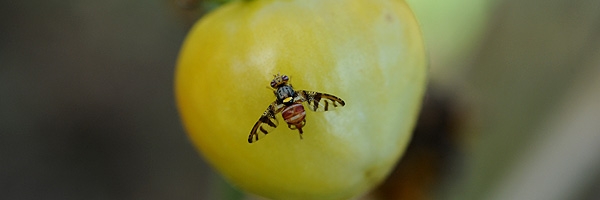
Originally from Madagascar, Neoceratitis cyanescens (Bezzi) (syn .: Trirhithromyia cyanescens , Pardalaspis cyanescens ) reached Réunion where its damage was mentioned in 1951, then Mauritius in 1958. Its presence in Mayotte, undoubtedly quite old, was reported in 1992.
N cyanescens is enfeoffed to plants in the Solanaceae family. The various cultivated species are victims of its attacks: tomato ( Solanum lycopersicum L.) in particular, but also eggplant ( Solanum melongena L.), chili ( Capsicum frutescens L.), pepper ( Capsicum annuum L.), tomato bush ( Cyphomandra betacea Sendtener), Solanum aethiopicum .
Various wild or subspontaneous Solanaceae also serve as a breeding ground for the species. This is the case at the Reunion of the brown bringellier ( Solanum auriculatum Ait.), The eel ( Solanum anguivi Lam.), And the black grouse ( Solanum nigrum L.).
- Taxonomy and description
This species belongs to the Tephritidae family, which has around 4,000 species worldwide, of which 250 are of economic importance. It is classified in the Dacinae subfamily and the Ceratitidini tribe. The adults are easily recognized by the characteristic design of the brown bands of their wings, and by their scutellum (posterior part of the thorax) entirely black in its apical half. The eggs , white and elongated, are slightly arched and about 1 mm long. They are laid in the host fruits in small packages, a few millimeters below the epidermis. The larva , yellowish in color, is a typical maggot: its slender anterior part has blackish mouth hooks, while the posterior part is truncated. At the end of 3 rd larval stage, it measures about 7-8 mm. The pupa , brown in color, is barrel-shaped and 4-5 mm long.
- Biology and damage
Mating begins very early after the emergence of adults (from 48 h), and can take place from morning until mid-afternoon, with a maximum frequency in the middle of the day. Like most other Tephritidae species, males attract females by emitting an active sex pheromone at close range. The laying of females begins 4 to 6 days after mating. Using their pointed oviscapte, the females deposit their eggs under the epidermis of the host fruit, a few millimeters deep. Egg-laying activity usually takes place in the afternoon, with a maximum between 4 and 5 p.m. The eggs hatch after 3 to 4 days of incubation. The larvae then sink into the fruit pulp where the larval cycle, which includes three stages, lasts from 7 to 11 days. At the end of development, the maggots leave the fruit with a sudden relaxation to sink shallowly into the soil, where pupation takes place. The stage pupa lasts 2 to 15 days. Thus, depending on the climatic conditions, the complete cycle is spread over 26 to 35 days. Studies of visual attractive stimuli show that adults of both sexes are preferentially attracted to fluorescent yellow, while mature females are strongly attracted to bright orange spheres. The study of attractive olfactory stimuli for adults should soon provide a suitable trap for monitoring populations.
Affected fruits show punctures corresponding to adult stings; they are generally clearly visible. At the same time as the development and damage associated with the activity of maggots, the fruits are colonized by various pathogenic or opportunistic pests which progressively cause them to rot. In Mayotte, this species causes significant damage to tomatoes, which can affect most of the harvest if left untreated.
- Protection methods
- Commonly practiced control methods still rely on the use of insecticides during the period of fruit susceptibility.
On small tomatoes, the first attacks appear very early, around ten days after flowering, when the diameter of the fruits reaches 2 cm. The attack rate then increases rapidly and reaches a maximum about 3 weeks after flowering. Older fruit may still be pitted, albeit more weakly. While waiting to have a suitable trap for monitoring, we can reason the fight by carrying out a visual check from the start of the fruit sensitivity period, in order to trigger the treatments when the first attacks appear.
- As soon as the first attacks are observed, it is important to remove and regularly destroy the stung fruits or bury them in order to limit the multiplication of populations.
- The various also be eliminated reservoir host plants that may be found near the production plots will .
- Certain natural auxiliaries can contribute to limiting the populations of N. cyanescens on reservoir plants or in untreated plots. A species of indigenous larval parasitoid, Psyttalia insignipennis (Granger) (= Austroopius ) was thus observed in Mayotte, with a reduced rate of parasitism (8%). The importation of other species of exotic parasitoids may also be considered in the context of future biological control operations.
* Chemical control : As the number of pesticides available for a given use is constantly changing, we advise you to always confirm your choice by consulting the e-phy site of the Ministry of Agriculture and Fisheries which is an online catalog of plant protection products and their uses, fertilizers and growing media approved in France. This also applies to all biological products based on microorganisms or natural substances.





